______________________________________________________________________________
I, Ken Aitken grew up in the 1950’s and 1960’s at Wilsons Creek, up in the mountains out from Mullumbimby in Northern New South Wales. I was raised on a banana plantation amidst the steep slopes of rainforest and wet sclerophyll (gum) forest and occasional cliff outcrops. The creek we swam in was a very clear, clean freshwater rainforest creek with big deep pools. People now in the City, would give their `eye’ teeth for it as my late father used to say.
Wilson’s Creek is about twenty minutes (about ten kilometres) up in one of the many valleys west of Mullumbimby, in the Northern Rivers area of New South Wales. With this time, came for me a strong spiritual love of Creation, Nature, Country Living and the Environment.
It was a hard and simple life with a Dad and Mom and three younger brothers (Gerald, Rick and Colin). My father had come through the Great Depression of the 1930’s. His father had died when he was only thirteen and he had had to leave home and fend for himself. He had learnt many lessons of self-sufficiency …. personally and economically.
I recently saw a DVD called ‘Liam’ a story a little boy called Liam growing up in Liverpool, England in an Irish Catholic family in the 1930’s. The Depression had just started and men where finding it hard to get work in the factories. Factories were closing down from lack of sales and there was no welfare at all. In the midst of growing tensions, there was a rigid traditional Catholic education for the small boy Liam.
There were racial tensions between the Irish versus English, prosperous Jews and grinding poverty of the working class. This poverty was all set all against a rising nationalism led by Mosely with his black-shirted followers (the equivalent of the German people who became the Nazis). The Unions were formulating their identity with a background of Communists advocating for promises of a better society with State-run endeavours.
People coped and made do with frugality and counting every bit of money and put up with a lot of hardship. Even the children worked partime to help the family budget. Sharing and helping out each other was common. It was real do-it-yourself approach to life with a practical wisdom and innovation born out of necessity. The Government wasn’t helping them …. They had to help themselves.
I now have a better understanding of what Dad had to go through to survive by himself in this period with himself alone. The conditions of the Depression were felt in many countries around the world, including Australia at the time. Now I understand the cultural attitudes of frugality, communal help and openness to others and at the same time self sufficiency, emphasis on innovation and practicality, a ‘no-frills’ approach to life and making do with what you have.
These lessons of a ‘do-it-yourself approach to life’ were passed on to us boys in different ways. They were more caught than taught by example. We could make anything for ourselves. As money was always tight, we would make our own fun and amusements individually and together. We would make our own toys and equipment such as billycarts, canoes, thatch huts, tree houses, American Indian suits out of cut and painted hessian, Indian ti-pis to match the theme, homemade chemistry sets and experimenting with electricity from torch batteries to name a few things.
In the 1950’s 240 volt electricity had just come up into the Wilsons Creek Valley. It was generated by the new hydroelectricity power station at the bottom of Laverty’s Gap which had built in 1926 to service the Brunswick Valley. The Gap was the junction between the lower Brunswick Valley and the higher Wilson’s Creek Valley. Water from the Wilson’s Creek flowed south behind the hills to reach the Richmond Valley and the Richmond River many kilometres downstream.
A small curved concrete weir at the Gap had been built which banked the water for several kilometres behind it in a long body of water. A narrow concrete race on the north side of the weir led down and through the Gap hills then dived through a tunnel through the hill to the lower water filtration plant halfway down the Gap. Water was directed by pipe to the township of Mullumbimby for domestic use. Excess water was run down the hill by a falling race and turned the turbines in the power station.
_________________________________________________________________________________________
The House, Garden and Farm:
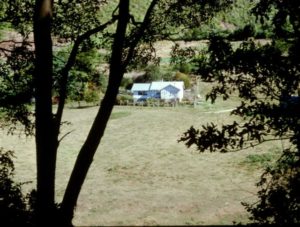
The house from a distance across the creek …… the house doesn’t exist now as it burnt down in 2012 with the renting of the house by the new owner David Dubens. However the photographs, memories and influences remain from growing up there.
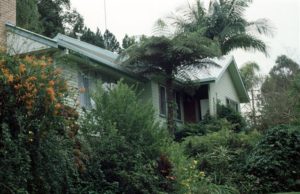
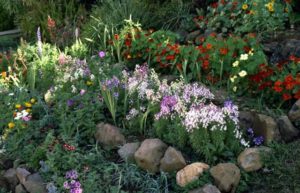
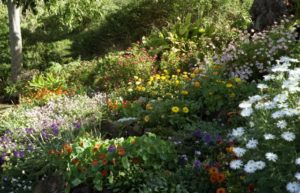
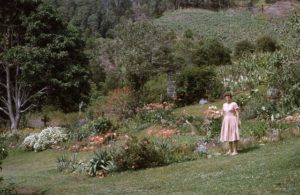
My mum Norma Aitken outside our simple house amidst her big garden grown on brown volcanic soil with much rainfall. The banana plantation is shown growing across the background slopes. Her flower garden is shown in detail below. This is the early 1960’s.
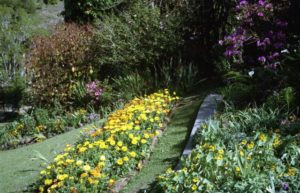
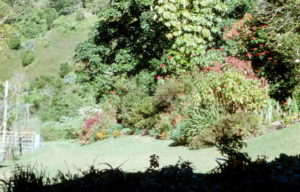
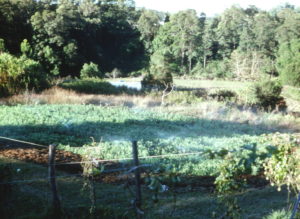
We had four growing boys and two adults and we needed to feed ourselves as much as possible. We had a big vegetable garden which grew all the vegetables we needed. This was the inspiration for our Permaculture Garden at our house at Chambers Flat in 2016 and onwards.
________________________________________________________________________________________
The Aitken Family in the late 1960’s:
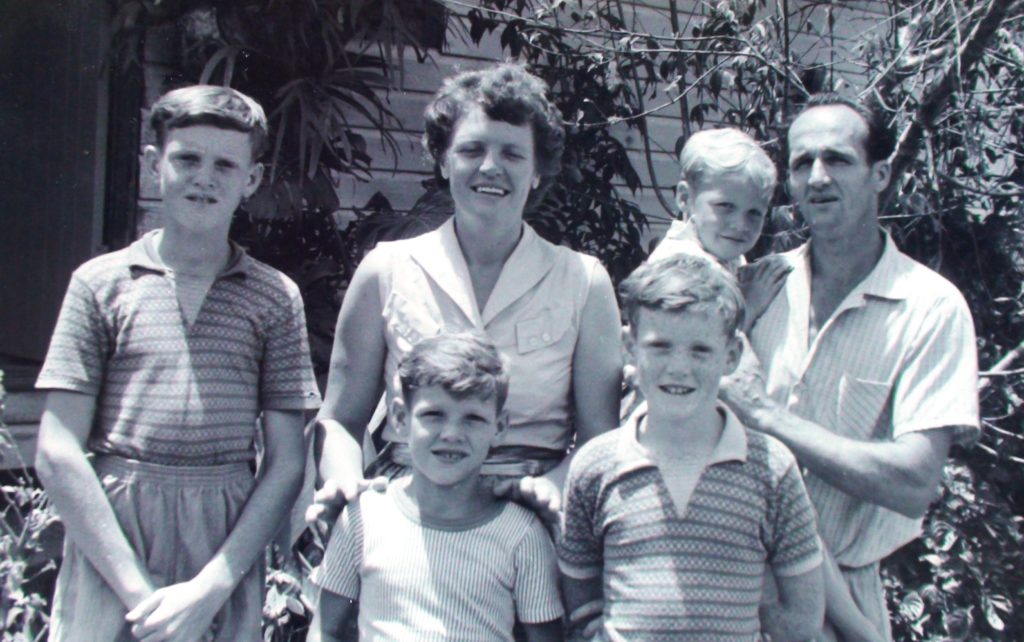
Ken on the far left then Mum with Rick then Gerald then Dad holding Colin
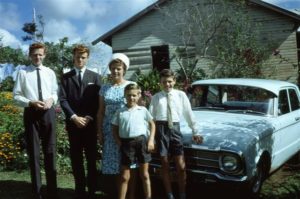
This Gerald, myself, Mum (the fashion was that all the woman wore hats in the 1960’s), Colin and Rick
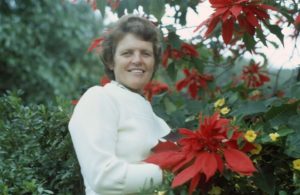
Mum beside some poinsettias flowers in her extensive garden
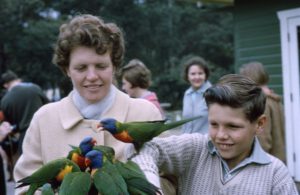
Mum & Rick: We visited the Currumbin Wildlife Sanctuary on the Gold Coast where we fed many lorikeets.
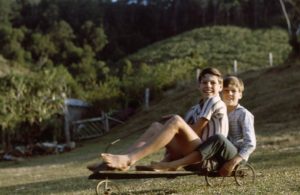
We were always making things for ourselves. We made our own billy carts out of a set of pram wheels. We used our feet as brakes on the grass as we came down the hill at a fast pace.

Mum and Dad with Gerald (the next brother down from me ) and Helene his wife and their son.
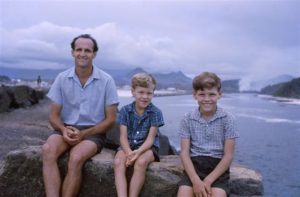
Dad sitting with Colin and Rick in the early 1960’s on a big rock at the seaward end of the Brunswick River.
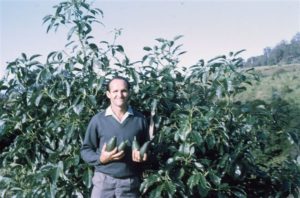
Dad with some of the fruit in his avocado plantation in the 1980’s
______________________________________________________________________________
The banana plantation:

Dad and I in the bananas in the late 1960’s. In the 1960’s Dad bought an additional plantation off Mr. Brown nearby. This photograph was taken outside Browns Packing Shed facing Brown’s extensive Avocado Plantation. We had special banana clothes as the sap from the cut stems would permanently stain your clothes. See the post on Mr. and Mrs. Brown: Browns House at Wilsons Creek as in January 2008
I talk more about bananas in this post: Banana Growing in the 1960’s …..
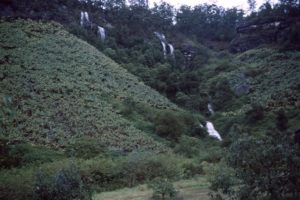
It was a simple life of hard physical work. During my teenage years I worked with my dad and my next younger brother Gerald, in the banana plantation and packing shed. We always had several house cows, a dozen or so chooks and a very large vegetable garden on brown volcanic soil. Did things grow! It was a very self sufficient lifestyle. Mum initially cut everyone’s hair with a pair of hand clippers which later changed to electric clippers …… short back and sides was the order of the day.
The country side was quite different to how it is now ……. It then consisted of open paddocks across our land and any neighbours land ….. the grass was kept short by cows grazing in the paddocks. There were occasional large trees standing in the open paddocks left over from the remnant rainforest which had been cleared in earlier years. Tree bands fringed the creeks which remained largely uncleared. It was an understood community principle that you could wander across any paddock or land of your neighbour. This principle began to gradually change in the early 1970’s and through to the 1980’s when people began to be more individualistic and protective of their land. The communal spirit began to disappear as a result.
In the 1960’s, my brothers I and walked the three kilometres or so, up along the gravel road to the main Wilsons Creek road to catch the school bus into Mullumbimby High School. This was through open paddocks which were a major problem in spring time due to the nesting magpies and pied butcher birds.
The magpies had a nest down in a lower paddock below the road we walked along. They were very protective of their nesting site and would attack us viciously. We used sticks being swung around our heads to repel them. Dad took a gun one year and shot them ….. they ceased to be a problem from then on. The butcher birds were another problem altogether. We only had to appear on the horizon of the open paddocks and we would see a small black and white speck flying towards us then it would appear as a pied butcher bird flying towards us. It would ascend high over us then dive bomb us at a fast rate. We used sticks being swung around our heads to repel them plus some yelling at them to cause them to fly off.
We walked in bare feet along the gravel track, carrying our shoes and socks up to the bus stop. Otherwise our shoes would have been thoroughly wet through from the dew on the grass. On some winter mornings there was frost on the grass going up the bend from the creek crossing. Our feet were a bit frozen going up the driveway until they thawed out.
My prior job before this going to High School in the 1960’s, was daily turning the manual milk separator for the milk and resultant cream. The skim milk was then fed manually to a weaned calf. The cream we used on everything from bread to Weetbix in the morning. There was always a dozen jars of cream in the fridge. Mum even occasionally made our own butter from the cream.
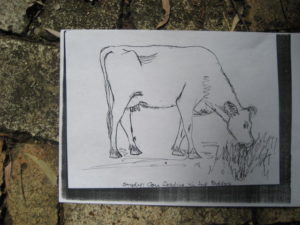
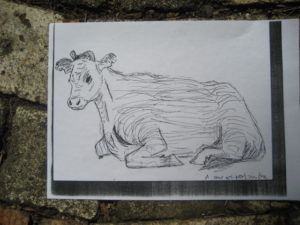
Dad had made a grinder from a combined electric motor and a hand-turned grinder. This ingenious labour saving device reduced whole wheat into heavy ground porridge meal in very short time …. delicious with brown sugar, milk and thick cream! We would have worked of any excess fat in the work during the day or on weekends.
The daily work was punctuated weekly in spending a day at church. I was brought as a Seventh Day Adventist Christian which meant keeping a weekly Sabbath like Old Testament Jews. This Sabbath was linked to a value for nature and the environment. In the Old Testament, the weekly Sabbath was a reminder of the Creation of the world in seven days in Genesis.
It was from this Sabbath teaching, I gained some wonderful perspectives. I now see these in a whole new light now since Harriet, my wife and I and many others left the Adventist Church in 1983. The ideas for the natural house we now live at Chambers Flat, grew out of my subsequent love for the environment.
In 1981, we built a unique natural house which people often come out to see. This is on our five acres of light open eucalypt bush at Chambers Flat, Brisbane. The house is largely of glass set into a post and lintel construction of 100-year old broadaxed timbers and sandstone walls. The total concept of indoor-outdoor flow, has a nice ambience to it and the design is unique and lends itself well to future development.
Harriet and I are into simplicity and recycling. We live in this amazing house built out of recycled, rejected materials and only bought material when necessary. See the following posts:
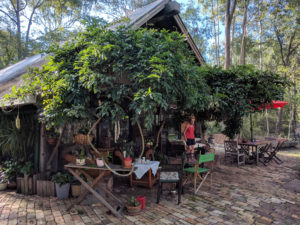
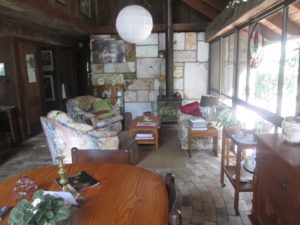
I also gained some other wonderful inner values which have endured throughout my life:
1. To be resourceful, innovative, self sufficient, and independent
2. To work hard in every thing
3. To be honest, caring and respectful of others and elders with good manners
4. To be tidy and organised in everything.
5. Family: My parents gave me the best they knew how. This included a very strong sense of extended communal family …. both personally within the family then the very strong relational family and then the extended communal family within the church community …… a commitment to others and a strong desire to see people in need always included in that family.
At times it was bit unpredictable as Dad sometimes was emotionally explosive when things didn’t fit his expectations. In that era you didn’t just get up and leave your spouse if things became difficult. You stuck it out and sorted the problems out in time.
As I write these memories, I wish for these sometimes to be like a flow of a stream of thoughts as reflections on life. Sometimes a memory is maybe attached to an understanding of life in a universal sense and sometimes it will be even poetically …. Rather than being a set of precise rational proposals. Life is often like this ….. it is an experience you go through which has no definite beginning and ending …. It simply flows into the next experience.
_________________________________________________________________________________
A Family Overview:
I invite you travel down some unexplored paths that you may never have travelled down before to a time which will never be repeated. For me, it is a unique time that was very foundational from a personality and character point of view. It is very much my account and my three brothers would have very different memories and would have had different focuses as per the description below …… we all came out with a difference in outlook on life even though we came from the same family:
_________________________________________________________________________________
Ken: I am more a lateral, creative yet practical thinker …….. into natural things and the environment and I was always roaming along the creek after new creek discoveries, trees, mosses and ferns etc. ….. this finally led me to doing a science degree at the University of QLD. in the early 1970’s …. Then I ran my own business in landscape design and construction for twenty years from 1975 to 1995.
In 1995 I had a bad fall off a boogi-board in the surf at Peregian beach which resulted in a very severe brain injury with a big bleed on the brain. I lost my ability to talk, walk and had a very scrambled brain. I was in hospital for six months. In rehabilitation I had learn to walk, talk and getting my very scrambled brain back again.
As I am on a life time insurance Income Protection policy, I do not have to work again and I now do some different things (I cannot drive twenty two years on from 2018). I went from being an outer gardener in physical gardens for wealthy clients to being a inner life gardener to hundreds of people around the world connected by the Internet with three websites and periodic e-mail broadcasts.
Read my story on this website: The Recycled Man as at August 2018
_________________________________________________________________________________
Gerald: a practical / technical person .……. more conservative than myself …… was always the one experimenting with electricity from torch batteries when he was a teenager …… initially with scissors connecting two torch batteries to light up a small globe …… he was always the one to help Dad repair the broken axle in the short wheel based Land Rover. After doing an apprenticeship in radio repairs in Mullumbimby in the late 1960’s he then married Helene in 1973, then went to Adelaide in South Australia.
Then he eventually went to Sydney to do courses in computer technical repair work for Canon and other companies. He was good at working in the corporate world. Then he went on to manage the service delivery of a contract for maintenance of Voice Systems (PABX’s/phone systems). His company he worked for was Telstra Business Systems (Damovo) which had a contract with Telstra & Defence Australia. Helene his wife was busy at Kimberly Clark, a personal assistant to the manager. The good part was that they both enjoyed their jobs. As of 2017 they are both retired and travel the world.
_________________________________________________________________________________
Rick: a creative thinker …. more intellectual than I was at studies etc. He went to Sydney to become a doctor. He married Diane in 1976. They then lived at a place on the coast at Culburra near Nowra. In the early 1990’s Rick became a Christian pastor of a new church under the umbrella of the Apostolic Church. It was a real communal church versus a hierarchical corporation style church. He was a part-time doctor and part – time pastor.
They moved up to Orange in the last few years from 2018 where he is a doctor in regional work. He is not a pastor now but maintains an active interest in people and their welfare. As of early 2018, he and Diane have moved down to Mosvale in Sydney to be close to their children.
_________________________________________________________________________________
Colin: a practical / technical person …….. a bit like Gerald but far more adventurous in eventually running his own business in an individual sense at Gosford of Sydney ….. it is a business to supply individually designed machines to fill bottles in factories. He married Leanne in 1984.
See his company website at: http://www.colpack.com.au/ From the website:
‘Collier Packaging Pty Ltd is an Australian company established in 1984 and operates from a state of the art manufacturing facility located at West Gosford, Australia.
The company has developed an extensive range of liquid filling and capping machinery and now supplies the cosmetic, automotive, chemical, food and pharmaceutical industries.
Filling and capping machines are assembled from an extensive range of stock components. High quality engineering and design means we can supply a machine to suit a wide range of products with minimal delivery time.
Collier Packaging Pty Ltd objective is to provide technical superior products at competitive prices and provide efficient service and technical support to all their clients.’
_________________________________________________________________________________
The one gift in life we all possess is an ability of having relationships with people in different ways ……… to creatively flow this ability into whatever context is at hand ….. whether business, the corporate world, doctoring the outer person or doctoring the inner person …. I think that is a fruit of growing up in our family …. very social overall with church activities etc. I still have wonderful memories of all the Pathfinder Camps and hikes we went on.
__________________________________________________________________________________________
Natural geographical features of the locality:
One of the main features of the site was the creek ….. it was a series of three large pools up to fifty metres across, joined together by rapids and boulders. These pools were edged by glass clear waters with darker shadows streaked by lighter translucent sun shafts falling through the edging trees in lighter colours. Water from the top rapids flowed into the first main pool which was our swimming pool which then flowed over tan-coloured rock shelves …… to flow into a deeper dark green pool below which was a much longer pool. In these pools we went fishing and swimming as kids. There were three large pools up to two metres deep: Pool 1, Pool 2, Pool 3.
_______________________________________________________________________________
Pool 1 was our swimming pool:
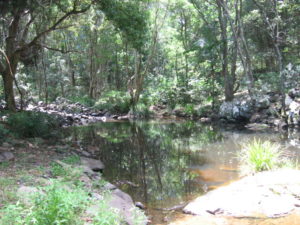
Pool 1: Photograph above shows the 1.50 metre high rocky boulder wall on the far side of the pool. This wall sloped down under the water for two metres to a rocky bottom with a 500 mm wide underwater rock shelf we swam to. It was about 300 mm below the surface.
Left hand side of the creek: Was where we entered the water ….. the bank sloped down to soft tan – brown river gravel then into shallow water …… this was where the creek flowed slowly around the outside southern edge of the pool … sand and gravel were partly covered by organic matter ….. fallen leaves were 200 – 300 mm deep … water was 500 mm deep here ….. whenever you walk here, it releases clouds of gas bubbles ….. one day in the early 1960’s with my chemistry set and books, I learn’t this was marsh gas or methane gas which was being released from the decomposing leaves …. The gas was trapped in the gravel and mud and was released when the surface of the gravel was broken.
I caught some of this gas in an inverted waterfilled glass jar where the bubbles arose and displaced the water ….. I put a lid on the jar and took it back to my chemistry set ….. I lit the gas and it burned with a slow blue flame like methylated spirits ….. so I knew it methane being released from the decomposing leaves.
When I was home in the 1950’s and the 1960’s I remember some of these things:
- How the rain and wind lashed around the eaves during cyclonic weather
- How I often played dams and paddle wheels made out of empty wooden cotton reels in the grass drain which cut across the hill behind the shed
- The tossing waves of the swollen creek. When a cyclone was coming down the coast and creek had come up, the flying fox enabled us freedom of movement in a cyclone …… Dad would drive the vehicle across to the other side of the creek and leave it there …… We could always go as a family into town or church when the weather was bad and creek was up.
- We would hear on the radio the progression of the cyclone down the coast and when it was expected to cross our section of coast. The creek would be transformed overnight into a huge tossing and surging sea of muddy water filling the whole creek to a depth of ten to twenty metres …… the rain just poured down day after day till the eye of the cyclone passed on and out to sea.
- When the rain had stopped, we would troop as a family down to the creek to see how high the creek came up in the middle of the night as invariably the eye of the cyclone had passed over in the middle of the night ….. it could come up around ten to twenty metres in height. We would then often go down to the engine room to see if the flood waters had come up anywhere near the engine room at the crossing …. It had been very high if had come up to there.
Description of the creek: our section of the creek consisted of alternating variations in the creek:
- The top pool which was our swimming hole as it had a gravelly sloping bottom going over to a two metre deep rocky bottom with a 250 mm underwater rock we could all swim to. The pool was about 30 metres across by 75 metres long
- Then a narrow constricted passage which glided over a 300 mm deep rock shelf to flow into a lower large pool … about 75 metres across by 200 metres long
- Then there was a series of large bouldery rapids for another 200 ++ metres
- Then there was Pool 3= Lower Pool. It was about 50 metres across by 75 metres long …… we rarely swam in here as there was not a good entry to the pool plus it was an uneven depth that was green and mysterious. I only fished here as it was good for catfish
- Then there was a series of large bouldery rapids again for another 200 ++ metres down to the concrete creek crossing which Dad built in the early 1960’s
- For me I was constantly exploring right down and above our section of creek. Virtually every tree grove, pool and boulder has some memory for me. I was out at the old property meeting the new people in 2001 and 2006 as the farm had been sold in 1995
- Swimming in the creek: as a family at the end of hot summer days ..… we used to leave our wet clothes to dry on the clumps of reeds
________________________________________________________________________________
Environmental Journalling in 2001 along the Creek:
Bird Calls: Through the creek bush comes repeated bird sounds (currawongs), the sounds cascade down among the forest trees …… bird sounds, the gentle sounds of moving water and the soft sounds of moving leaves in the occasional breeze interweave together through the rich greenness.
The upper end of the pool is backed by a watergum forest in trim 100 – 200 mm cream – fawn smooth trunks …. Often in multiples of two or three trunks arising next to each other ….. occasional trunks marked out in smooth cream bark but other trunks in darker bark …… lomandra sedges in dark green blades …. Tussocky at the base near the waters edge ….. soft filtered light alights on the dark green leaves alternatively with dark then light green leaves.
See further Journalling in this area below.
![[29870315.jpg]](http://3.bp.blogspot.com/_AeubvHTQ4FI/RjWEcZTSJ7I/AAAAAAAAARs/5SjTaPh7BDU/s1600/29870315.jpg)
On the far side of this watergum forest was a ten metre long waterfilled pool with largely vertical sides in large river gravel carved out by recent floods. At pockets in the pool were growing an interesting variety of ferns with a clumping format. These were fishbone ferns (Blechnum Nudum) See photos below. These become an important fern being grown in Mum & Dad’s wholesale nursery in the mid 1980’s and early 1990’s. They sold the whole property in 1995 and moved down to Ocean Shores.
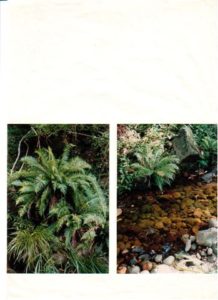
________________________________________________________________________________
Fishing in the creek:
In 1992, Peter and Brett Aitken (my brother, Gerald’s boys) were fishing on one of their infrequent family holiday visits to Wilsons Creek from Adelaide. Peter eventually caught an eel. Was he excited !!

Fishing in the creek: There was always a great sense of wonder and excitement for me personally ….. fishing off the middle rocks between the upper and lower pools ….. for catfish, eels and especially mudgudgeons ….. small fish of maximum length of 175 mm ….. a monster at that length ….. I would catch them on a short bit of line tied to a straight willowy tree branch with a small hook and sinker and a cork float ….. you could see them from 3.00 metres on the tan coloured river gravel on the pool bottom in the clear water …. a tin of worms could be obtained by turning over Mum’s garden edging stones and finding them underneath in the moist red – brown soil ….. worms which were thick and lively attracted the mudgudgeons with their twisting movement on the hook …. I would take my small catch proudly up to the house and I would get one of Mum’s Vacola bottling lids on the slow combustion wood stove and cook my catch of fish in the 100 mm wide lid.
One big mudgudgeon I kept for about a year in a cut down old concrete wash tub near the tap near the upper laundry shed …. I turned it into an aquarium with 50 mm of clean river gravel in the bottom and a small blue flowering water lily obtained from way across on Watson’s land from the billabong on the edge of the big Wilsons Creek Dam ……. I used to feed it with worms everyday …. Eventually the fish would rise up and take worms from my fingers 20 mm out of the water.
We didn’t eat catfish as they didn’t have scales as per the Biblical injunction in the Old Testament (We were Seventh Day Adventist Christians) ….. I often gave these away to the Graham’s, the neighbours on the adjacent property next door.
________________________________________________________________________________
Skin Diving in the creek: I made my first underwater mask out of a section of inner tyre tube stretched over a small face – sized frame from a cut down wooden lid of a banana crate which enclosed a single glass from a disused torch ………. Sealed with tar obtained from spent batteries from the old style of valve radios ….. I eventuated graduated to my first store-bought mask which fitted more snugly in a waterproof manner …….. I remember swimming up the top rapid shallows in the above pool ….. the clear tumbling and eddying water among the rocks …… seeing the beautiful minnows cavorting in a school of glimmering gold with a stripe of crimson on their sides.
________________________________________________________________________________
Pool 2 = Lower Pool: …… we rarely swam in this pool as it didn’t have a very good entry point into the water as kids ….. was suddenly up to 2.00 m deep at the top end when it flowed over the top rock shelves then eventually got to 1.5 m then into underwater boulders at the far end at 100 + metres.

Mr. Walker: In the early 1960’s, there was a bachelor man, a Mr. Walker who lived in a small timber cottage nearby where the garage eventually was eventually built in the early 1980’s ….. about one hundred and fifty metres away from the house.
He always went to this big pool as shown above to get his kerosene tin of water. There was a big freshwater cod in the shallows. He went back to get his gun and when came back, it had moved into deeper water. He went back and got a hand line and caught the huge fish ….it had a head about 30 mm. across. He gave us a filleted slab to cook but mum had to cook it up in the pressure cooker …… it was so tough!
There used to be many big freshwater cod in the creek when the timber getters came out in the late 1800’s looking for cedar logs. They would blow up the pools with dynamite to get the fish. Freshwater cod in the creek became very rare after this period. For Mr. Walker to even see and catch a big freshwater cod was a very rare thing.

Pool 2 = Lower Pool … Description: a dark green rainforest pool overhung on the north-eastern side by 50 metre high brush box trees …… smooth tan trunks spreading into elongated branches ending in bunches of very dark green lanceolate leaves ……. Small white flowers eventually retracting into dark brown cupped seed capsules ….. bark is tan coloured with smooth but fibrous texture …… A steep 45 degree bank of red soil ….. descends to the edges of the pool …. Interspersed with large rainforest trees and occasional tall thin trunked Leichhardt’s Tree ferns …. Elegant black trunks with an expanding whorl of 2.0 m long fronds …. bright summer sunlight broken up into shafts of golden light in amongst the tree canopy ….. they strike the glass – like water in bright shafts of liquid gold probing the green depths amongst boulders and the occasional sunken log … the shafts of light give way to solid shadows of rainforest green in the depths hiding the big 2.00 m long eel … the light in other areas searching the washed tan – brown – cream river gravel creek bottom where the 400 mm long catfish has made it’s concentric ringed nest of graded gravel ….. the centre is a coarse gravel gives way to ripples of lighter gravel ….. the dark shape of the catfish gracefully glides out over the pool depths and slowly circulates over the ringed shapes …… the centre of the rings is where the eggs have been laid.
On the south western side of the pool is a blue quandong tree (Eleocarpus grandis) ….. now grown to 100 metres high in 2005 ….. it had grown from a ten metre high tree in the 1970’s ….. a very fast growing tree with light fawn bark in splotches of darker browns merging with lighter browns …. 150 mm thick branches are splayed outwards in radiating pattern of ten metre long limbs …. Branches end in bunches of dark lanceolate leaves with serrated edges ….. in the right season, the tree has 30 mm. green globular fruit which eventually turned dark blue …. the leaves were a mixture of dark red and others being dark green …. These trees are frequent creek-side trees and when the fruit falls into the creek or eaten by birds, the flesh rots off to leave a 20 mm wavy crenelated woody seed which gets washed down the creek with the river gravel in flood-time …. this often sprouts by the creek into a new tree to form fringing rainforest along the creek.
________________________________________________________________________________
Pool 3 = Catfish Waterhole:
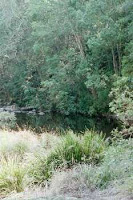
Pool 3: We didn’t swim here as Pool 1 with its gravelly entry provided a far easier entry to the water. It was also much further from the house. There were just vertical rocks which fell away into deep green water. It was always a beautiful pool to explore as it had a steep bank on the eastern side which gave an enclosed feeling. It then had rainforest trees which further enclosed it the pool area into mysterious deep green corners.
It was a good catfish fishing hole so I found out. I was the fisherman and I loved to fish. I had a long straight branch as a fishing pole. To the top of the branch, I had tied a three metre length of translucent fishing line. To the end of this line I had an adjustable cork then a large hook. To the hook I would thread on a wriggling earth worm as bait. Catfish just loved wriggling earth worms as bait. I would flick the line out, adjust the floating cork so that the bait was at a suitable depth. I would wait for the cork to bob under and knew I had caught a catfish. I would bring it in slowly and place the fish in a bucket.
ABORIGINAL CAMP BY THE LOWER POOL: …. as told by Mr. Brown. Mr. and Mrs. Brown had come out to Wilsons Creek in the bullock trail days of the early 1900’s to clear their land, grow bananas on the steep slopes and build their big house with its cream painted weatherboard sides, galvanised tin roof and big wide verandas. Mum had gone over to see Mrs. Brown to have a cup of tea and socialise …. this was in the late 1950’s. See Bullock cart From Wikipedia, the free encyclopedia. See what it says on the use of bullock teams and bullock carts.
Mr. Brown used to tell us of how there was an Aboriginal camp by the lower pool on our property.
Flying Fox Wire across Pool 2 … was for getting to the house if the creek was in flood. One day Dad and Gerald came down on a pulley and wire and just missed the floodwaters. See the photograph of Helene Aitken (nee Jenkins) before she married Gerald Aitken, my brother in 1973 ….. going over on the wire in a flooded creek time below the swimming pool.
The other flying fox wire was right down the creek further at the crossing and engine room area of the creek. This was an important access point to the property. Vehicle access normally was via a low level concrete crossing that Dad built with help from my Grandpa in the early 1960’s. See the photo below.
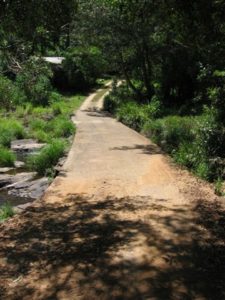
Low level concrete crossing with the exit road on the other side going up to the house
_________________________________________________________
Flying Fox Wire Across The Low level Concrete Crossing: When the creek was in flood, Dad had built a main flying fox across the creek to help us all get access to the other side. Flying foxes were a popular way of crossing the creek and were regularly used up and down the creek by other property owners.
This flying fox consisted of two sturdy upright posts on either side of the creek. Then two heavy duty banana wires were wrapped around each other and were then strung between the posts.
A simple pulley system was then used to get us all across the creek. This consisted a banana pulley with a rope attached to a wooden seat which was a big round stick. You hooked the pulley to the wire and sat on the seat. You then slowly pulled yourself by hand across the flooded creek to the other side. You then unhooked yourself and the next person could then come across the wire.
I still remember pulling myself across on the wire and being about a metre above tossing brown floodwaters from a cyclone that had passed through the region. It was a welcome relief to reach the other side.
There were several seats and pulleys on either side of the creek to be used by Dad & Mum and us four boys. When the whole family was across, you would then get in the parked vehicle and go into town. In flood times, Dad would park the Land Rover on the other side of the creek in anticipation of a coming flood. Having a Land Rover meant that you had 4-wheel drive if you needed it. The road into our property could get very muddy in wet weather.
The flying fox over the creek at the engine room to get to Mullumbimby High School (1961 – 1967). Dad put in two stout posts on either side of the creek with a double banana wire between them ….. the whole family would jump on separate pulleys and pull ourselves across to the other side ….. Each pulley had a short rope and thick stick between your legs … I remember my feet barely a metre off the tossing brown water as I pulled myself over on the pulley …. I walked with my two of my brothers up to Wilsons Creek Rd. to catch the High School bus into Mullumbimby ….. then doing the same in the afternoon after school.
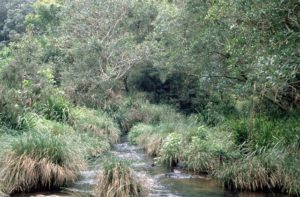
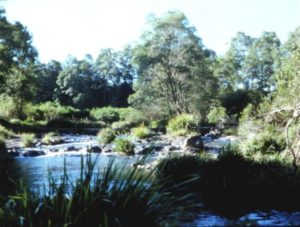
Large bouldery rapids flowed as a series from Pool 3 for 200 ++ metres down to the concrete creek crossing which Dad built in the early 1960’s.
__________________________________________________________________________________________
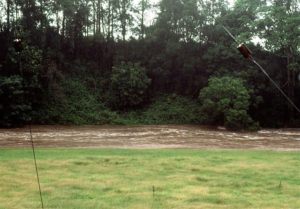
Floods and cyclones: which came nearly every year in the 1950’s, 1960’s and early 1970’s ….. swirling air would form into a low pressure system over a whole region and would initially gather up in the Coral Sea up north …… forming into a rain depression or cyclone which would rotate clockwise to pass moisture laden air onto the coast from off the sea …… then it moved progressively down the coast to cross our section of the coast in the eye of the cyclone …. This meant the eye of the cyclone was only moving dry air off the land into itself which swirled around to become moisture laden air directed onto the coast.
When a cyclone was coming down the coast and creek had come up, the flying fox enabled us freedom of movement in a cyclone …… Dad would drive the vehicle across to the other side of the creek and leave it there …… We could always go as a family into town or church when the weather was bad and creek was up.
We would hear on the radio the progression of the cyclone down the coast and when it was expected to cross our section of coast. The creek would be transformed overnight into a huge tossing and surging sea of muddy water filling the whole creek to a depth of ten to twenty metres …… the rain just poured down day after day till the eye of the cyclone passed on and out to sea.
When the rain had stopped, we would troop as a family down the creek to see how high the creek came up in the middle of the night as invariably the eye of the cyclone had passed over in the middle of the night ….. it could come up around ten to twenty metres in height. We would then often go down the engine room to see if the flood waters had come up anywhere near the engine room at the crossing …. It had been very high if had come up to there.
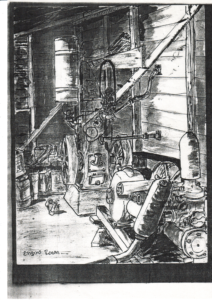 The hand drawing of the engine room I did in 1966 for my Art Class at Mullumbimby High School in Northern NSW. I left High School at the end of 1967. In 1968 I left home to begin a new section of my life in Tertiary Education at Avondale College at Cooranbong right down near Morisset, near Newcastle in New South Wales. I went to do a Science Degree. I had a Commonwealth Scholarship to go to the College. Read my stories: The Train Story and the Cairns Story.
The hand drawing of the engine room I did in 1966 for my Art Class at Mullumbimby High School in Northern NSW. I left High School at the end of 1967. In 1968 I left home to begin a new section of my life in Tertiary Education at Avondale College at Cooranbong right down near Morisset, near Newcastle in New South Wales. I went to do a Science Degree. I had a Commonwealth Scholarship to go to the College. Read my stories: The Train Story and the Cairns Story.
I stayed there for two years (1968 / 1969), (Physics didn’t agree with me! …. I had to pass that to keep my Commonwealth Scholarship) then I came up to Brisbane to live. I finished a Science degree (in biological science) at the University of Queensland in 1974. The Federal Government provided free university fees in that era compared to the Hex fee arrangements which are part of the Federal Government’s policy now.
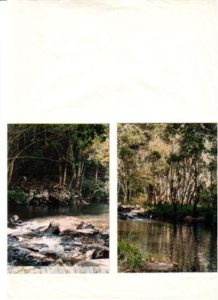

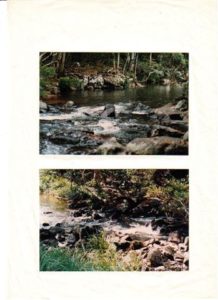
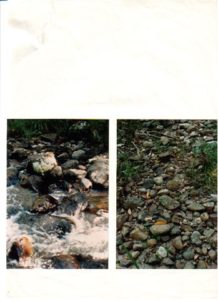 ________________________________________________________________________________________
________________________________________________________________________________________
Brown’s House:
Their house was quite a significant house in the district. It was a large timber house on a distant hill across the valley from us. Browns had come out to Wilsons Creek in the bullock trail days of the early 1900’s to clear their land, grow bananas on the slopes and build their big house with its cream painted weatherboards, tin roof and big wide verandas. Mum had gone over to see Mrs. Brown to have a cup of tea and socialise. I was very small …. About six or seven … I was eating an Arnott’s milk biscuits and drinking a cup of milk ….. I was dipping the biscuit in the milk …. I still occasionally dunk my biscuit in my hot drink to this day. I was swinging and climbing in the frangipani trees out the back of Browns …. the few frangipani trees planted down our driveway at Chambers Flat are a reminder of these experiences.
See the post on this website: Browns House at Wilsons Creek as in January 2008
______________________________________________________________________________________
Upper Wilsons Creek: Large rounded basalt bush boulders, creek in clear, crystalline waters, water as a meandering maze of water amongst the boulders, occasional large pools in a bend in the creek, creek bordered by pockets of Bangalow palms (Australian Rainforest Palms) on flat ground, creek generally bordered by dense closed rainforest on the slopes, rainforest of a dense dark green leaf canopy with an understorey of tree ferns, wild ginger with large green leaves, cordylines with the large green strap – like leaves and single spindly trunk, tree ferns with their tall fibrous trunks and their cavorting fern fronds that reach out over over smaller plants.
When an open ridge appears, you have a glimpse through the trees to the valley below. There is partly cleared rainforest to give open paddocks fenced in for cows. See the photos below. Distant sharp ridges rise sharply out of the surrounding valley.
See the photos of Upper Wilsons Creek here:
__________________________________________________________________________________________
A new man, David Dubens now owns the property. I get on very well with him. I have been out to the old property several times with my wife Harriet. I have have come to realise that our land and house at Chambers Flat Queensland, was very influenced and inspired by growing up here at Wilsons Creek.
See the many hyperlinked posts on our house and garden:
________________________________________________________________________________________
Family Outings: Some memories …..
Day Trips to Byron Bay to see the whale catching …. Seeing the long Byron jetty going way out into the ocean when the whale catchers came in ….. the slip – way up which they snigged the whales …… the tram that they were then loaded onto …. the whaling station ….. sharp flensing knives on wooden handles being wielded ….. cutting a huge side off the whale like a huge fish fillet as they snigged with a wire rope and hook …. the side up to the slipway to be boiled down for whale oil.
I read old newspaper clippings and memoirs about whaling in Byron from 1954 to 1962. To read about the history of whaling at Byron Bay, read these websites:
- Byron?s whaling past
- When Byron Bay was a whaling town
- Byron Bay’s jetty .…. especially see View Photo Gallery in full screen. In 2018, there is no trace of the jetty or whaling station as having existed at all.
__________________________________________________________________________________________
Pipping with Dad and us boys in the sand and water near the edge of the jetty …. twisting our feet in the sand for the feel of the pippies …. Hundreds of pippies for the chooks …. Also earlier than this time, going to Byron Bay up from the jetty …. Schools of mullet coming in ….. the commercial fisherman rowing with their nets and pulling them up on the beach … we were helping them to get them out of the nets …. Going to the fish co-op up from the jetty and buying a few … Dad filleting them and throwing the backbones down the back behind our two room packing shed … I remember looking at the bare backbones the next morning.
__________________________________________________________________________________________
Camping At Brunswick Heads: We would often camp at Brunswick at Massey Green Caravan Park in a tent in the Christmas holidays in the 1960’s. In the early 1960’s there were just
bare sandbanks along the entire river to the estuary bar leading to the open ocean. The
trawler Fleet would be moored at a series of wooden posts with a wooden ramps. When the
tide came in, the ramps would be cut off by deep water behind the ramps. Groups of teenagers would fish with handlines off the ramps and off the backs of the trawlers. You
catch bream, whiting and the occasional flathead.
__________________________________________________________________________________________
I remember fishing with handlines with Dad along the sandbars going out towards the bar. In the early 1960’s that all changed. The local council began to build basalt boulder walls all along the river from a purpose built trawler harbour to walls that extended the bar out beyond the beach on the north and south side of the river. This was to give the trawlers a safe passage at any tide … to exit or enter the river. It was otherwise very dangerous to exit of or enter river on a lower tide. The trawlers could easily capsize with the rough water.
__________________________________________________________________________________________
KOONYUM RANGE: The Koonyum Range was a range of forested hills on the northern side of us, right above the the main Wilsons Creek road. Dad would often go up there to get firewood and cut stringy-bark fence posts. Dad had obtained permission to get these things from an owner of a large forested area up there. He would go up there in his large 4 wheel drive Landrover to get posts and firewood. The earth road through the many vertical trees looked like this:
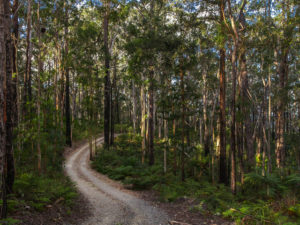
A section of the Koonyum Range …. The access road among tall trees
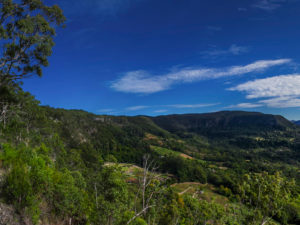
When we up with him, it would be like going on an adventure. Going up to the Koonyum Range was very interesting. The initial journey in was across relatively level contours in rolling green farmland that was fenced in. It was grass on red soil. Red soil was common in the area, resulting from the decomposition of basalt lava from the Mt. Warning volcano.
You then came to a very steep section that entered the forested section of the Koonyum Range. It then flattened out on top with an undulating earth road set among dry sclerophyll forest as in the photo above. In one section the slope fell steeply on the righthand side of the road. There were many dry treeferns down the slope among the eucalypt trees.
As we went through other sections of the road, it flattened out and there were many square metres of metre high culcita fern growing in a continuous cover of green as shown in the photo above. Dad would point and name the various eucalypt trees in the forest eg. black butt, stringybark, bloodwood trees. Then he would stop and point out ground orchids.
These experiences also led me to a love of Creation and the natural environment, my subsequent love of chemistry and building my home-made chemistry set in the 1960’s. These experiences also led me into building our house in 1981 out of recycled beams, stone and glass looking out into ten garden rooms around our house at Chambers Flat, Queensland.
See these posts:
· OUR HOUSE …. The Actual Garden
We would visit these things:
THE CAVES AREA: this was down in a gully of volcanic tuff This was a soft rock made of many particles blown out a volcano as volcanic ash. It erodes very easy into gulleys with constant water erosion as in a creek formation. These gulleys grow many ferns and tree ferns. It was always exciting to stop and explore along these creek gulleys.
In one of these gulleys was a system of three connected caves which had been hollowed out by running water. Each cave became larger as they went down the hill. The first cave was entered by carefully climbing down a metre wide hole into a fairly dark vertical tunnel. This first cave was very low and could only be entered by squatting and moving down to the 2nd cave which was head height. A gravel floor was formed of many broken up small rocks. This cave went into the third cave. The third cave was a huge cave which faced downwards and outwards into the creek gulley going down the hill. The open cave mouth was up to 10 metres in height.
The outside walls of the cave area, was open to the weather and the natural environment. The volcanic tuff cliff walls were covered with dark lichens and green moss. On the these cliff faces were small rock orchids which grew small pink orchid flowers. As we were all interested in plants, we would collect these to take home and grow.
One day, Rick my third brother, found aboriginal axe heads in the lower cave. This was very rare find as it shown tangible evidence that a tribe of aboriginal people lived and fed off this area of land long before white people came up bullock trails in the late 1800’s looking for red cedar timber.
THE LOOKOUT AND FALLS IN THE NATURE RESERVE: the lookout was a high level area with no trees and low mountain heath. You could look out to the east across the Brunswick Valley, see the town of Mullumbimby and see the Pacific Ocean.
In other section was a nature reserve with a small creek running through it. You could walk down the creek amidst the wonderful sounds of gurgling water and the creek edges of ferns and sedges. You would come a small waterfall over which the creek cascaded down to far bottom. It was a truly delightful nature walk in the Koonyum Range.
_________________________________________________________________________________________
The Reason For This Story:
My growing up at Wilsons Creek represented something that was very special … a view on life that is applicable to everyone I meet now. Then it was like a seedbed for the whole of my future life (not that I knew it at the time). This quality of this specialness of life was either learned in a conscious way or learned by participation with others. I call this quality ‘The Sustainable Life’ …. This life has the ability to be continually renewed and maintained everyday on an individual inner basis. I find myself doing something now and then have realised I learned it in my growing up at Wilsons Creek.
There are three important components in maintaining a Sustainable Life. These are: Structure, Social Network and Spirituality. Each of these components act like legs on a tripod which sit on large rock near the ocean. When the storms and waves of life of life come (as in a severe brain injury which the author experienced in December 1995), if the legs are strong, the waves will go over you but you will sit firmly on the rock of life. If one of the legs is weak, the tripod of your life will fall over in what you could call an Unsustainable Life. As I have a Christian Spirituality, the rock of life is God and His surety of life. Such a spirituality is central to my restoration in the last ten years. It is a very wholistic view on the whole of life of Inner, Middle and Outer Persons.
We are also like a vacuum cleaner ….. nothing really happens in our life until we are plugged into the vertical Universal Power Source which is God. However, if you never plug it in, nothing happens.
Spirituality is implicit (inwardly self evident and undefined). It refers to how an individual lives meaningfully with the ultimate questions of life, his or her response to the deepest truths of the universe as he or she apprehends these. It answers such queries as:
- Who are we as a people?
- What is the meaning of life?
- What values should I live by?
It is not a rational experience of the mind ….. of just a belief in something but is a dynamic quality of life which interacts with everything you do. It is very practical in the way it affects your work, family and social network and the whole of life.
Instead of being a rational experience of the mind, it is instead a living, ongoing relationship with God through His Spirit and set ultimately in His revealed written Word in the Bible. It is Spirituality vs. Religion. See the next section ‘Christian Worldview as a Source of Life’ for more detailed view on this spirituality. Read the section below: ‘Christian Worldview as a Source of Life’.
On the other hand, Religion is the antithesis of spirituality. It is explicit (outwardly evident and defined) and is marked by four things: a cult, creed, code (ethics) and community (which is more inward looking). It ends up being very law-centred …. Focussing on precise ways of living life ….. it ends up with very defined set of expectations and precise programs.
I was reflecting on this further of how life is like a forest. A forest is made up of certain trees of the same kind eg. A rainforest has trees with broad leaves and often large trunks. Small seedling trees are growing on the forest floor in a waiting stage. They cannot grow because the growth of the large trees above doesn’t permit enough light from the sun above to allow growth of then new tree.
However, if a big trees dies or falls over, the new space is quickly taken up by the growth of a new tree growing from the forest floor.
In a forest there are physical trees which can be seen in obvious ways. However, what is unseen is the hidden effects and connections between the trees in the ‘spaces in between the trees’. This was the source of the statement above ‘Finding these hidden qualities is something that really spoke to me from the beginning. Everything had a ‘to be explored’ quality to it ….. ‘The Hiddeness Of Life … In the Mulch and Earth of Life’ ….. Life therefore was an exciting journey of discovery for me’.
The ‘spaces in between the trees’ of life is where values in life and our attitudes to life and other people come from. They cannot be seen but they come out in demonstrable ways to effect everything we do. Life is an ‘Inside-Out Approach’ to life rather than ‘Outside-Inside Approach’ to life. Life changes from ‘Inside to the Outside’ and not from ‘Outside to-Inside’.
In this story, the insights for a Sustainable Life were discerned in every personal experience. They were never discrete entities but flowed together in different combinations. I have had in the following insights:
- Structure: Life had a lot of order to everything …. Work was there which helped defined order …. Things were done whether you felt like it or not …… there was a daily and weekly rhythm to it all.
- Social Network: Every facet of life had a social network application ….. lessons of life were learned personally or in groups and had relevance for sharing with others …. Either in them experiencing the group experience or being taught in conscious way…… life was about giving to others which came back to you many fold over.
- Spirituality: I learned a very real lesson in that God was not contained in a church building or church system …… God was the infinite – personal God of the Cosmos …. The Creator of everything. All creation showed something of this Creator in its beauty, integration and interdependence …. Because Wilsons Creek was a very natural place, everything had an undiscovered spiritual quality to it. Finding these hidden qualities is something that really spoke to me from the beginning. Everything had a ‘to be explored’ quality to it ….. ‘The Hiddeness Of Life … In the Mulch and Earth of Life’ ….. Life therefore was an exciting journey of discovery for me. This is the source of this biography as a whole.
_________________________________________________________________________________
Christian Worldview as a Source of Life ….
I attribute my ongoing recovery from a severe brain injury in December 1995 primarily to my Christian Spirituality which had its seedbed in my Wilsons Creek days. This has brought healing, restoration and transformation of life purpose. A Christian spirituality comes as a consequence of having a Christian Worldview. It isn’t another Spirituality in the Postmodern Culture of many spiritualities which are seen to be all equal.
It is a unique Spirituality which integrates the whole of life … of the Inner, Middle and Outer Persons {Spirit, Soul (= mind, will and emotions), and Body}. It means being a disciple of the Person of Jesus Christ, not a follower of a Church as a corporation. A Christian spirituality could also be termed a `Spirituality from Jesus Christ’.
A Christian Worldview sees that there are two worlds which are totally interconnected. The first is a visible physical world that you and I are part of. The second is an invisible, but very real, spiritual world where God is …. as God is Spirit. It is just as real as the first one …… you work in it with real results.
God is the infinite-personal God …. infinite – because God is outside the Cosmos and personal because God can be known in personal relationships by His Spirit. God is always the One coming to us to seek a relationship with us and not the other way round of us searching for God. It is not where we are seeking a higher spirituality reality through a particular spiritual path.
That is the major difference with other spiritualities. God comes to us and reveals Himself to us initially in His written Word, then in the person of Jesus Christ who was God and then by His Holy Spirit who Jesus gave as his personal representative after His Resurrection 2000 years ago.
A major consequence of a Christian Spirituality is that you have two dimensions of life you enter into. The first one is initially ‘a vertical one’ ….. a relationship with God as Heavenly Father made possible through Jesus Christ as the Son of God. In this relationship you are given a new identity through the living, dying and rising of the person of Jesus Christ.
The second dimension comes as a fruit of the first. It is a horizontal dimension of purpose. It is a God-given personal purpose for being in this world ….. why are you here? You have what is termed ‘a calling in life’ which may or may not involve your working in an occupation but goes way beyond your occupation. To help to accomplish that purpose you are given special abilities. Life is like a glass of water. If I sit the glass on a shelf for a while, especially in the sun, it will go green with algae and is no good for me or anyone. If I give the glass of water away to a thirsty person, straight away, I can then refill the glass for another person. God’s spiritual life to us is like that …. There is an endless supply that is very thirst quenching water of life.
‘You are there for other people’ as Albert Einstein said long ago, ‘ …. not for what you can get from them but what you can impart into their lives for good in an inner sense’. We are here for one another …… I have a component of life that you need and you have a component of life that I need. We are interdependent with each other and not independent. Life is like a community ….. we are here for the common good of others.If we are here for one another, we find another life problem we need to grapple with, ‘Do You live a Whole Life or do you have a Hole in your Life’? Life without God is incomplete, whether we discern it or not. We can be very accomplished on the outside but deep down inside there something missing. We have lost the centre of our life. We have a big black Hole in the Soul individually and corporately as a culture. We can try and fill this with more materialistic achievements or things. However, there will still remain an inner emptiness and vacuum which only a spiritual dimension can fill.
This ‘Hole in the Soul’ idea was illustrated to me recently by a friend of mine who shares this idea. He was on a plane journey going overseas and he got into a very open and friendly discussion about life with his fellow passenger. This man told him how he had risen to the highest level in his company and how he had retired with more money than he could spend in life time. Yet there was still something missing. There was an inner lack of meaning and fulfillment in the midst of all that he had accomplished. This came down to a discussion on what was really missing – a spiritual dimension.
A Christian Spirituality isn’t about a vague, unknowable and far off spirituality which we reach out for. There are certainly rational dimensions to this spirituality but these come as consequences of getting to know God. You can get real answers to prayer for anything, even physical healing. God is really there for you.
One of the followers of the Messiah Jesus wrote: ‘ …….. when the true worshippers will worship the Father in spirit and truth; for the Father is seeking such to worship Him. God is Spirit and those who worship Him must worship Him in spirit and truth ‘ (John’s Gospel Chapt. 4 vss 23, 24)
He was writing about truth concerning God and the whole of life. It isn’t just true for John but for all readers. It was a ‘True Truth’ communicated by God who sees the whole Cosmos as the large picture plus you and me as part of the detailed small picture. Seeing God is the Creator of all things, God knows the final truth. This truth was communicated by prophets and seers over many years and finally in person in Jesus of Nazareth who was God Himself in human form. These truths were collated in the Bible which consists of sixty six books written by people who didn’t often know each other over 1500 years, yet whose writing manifests an amazing unity.
In the beginning humanity had a relationship with this infinite – personal God of the Cosmos. We were made in God’s Image. This relationship became broken on our side, not God’s side. It was an irreconcilable breakdown with major universal consequences for God and us. Jesus Christ came 2000 years ago as the God-Man. Here was not another prophet of God just to tell us about how we can reach God, but of God reaching out to us.
Jesus the Messiah came as God in human form to connect us to a God who sought to ensure personal relationships with people. He restored that relationship again through His death on a Roman Cross. Jesus Christ was bodily resurrected and gave His Holy Spirit to us as His continuing personal representative to commence a lifelong recycling process through a personal relationship with Jesus Christ by the Holy Spirit. We voluntarily enter into this life long relationship. Recycling is from ‘The Inside – Out’ and not the ‘The Outside – In’.
____________________________________________________________________________________
Personal Overview, A Summary:
- I left home in 1968 to attend the Adventist Tertiary College ’Avondale’ at Cooranbong below Newcastle
- I then came up to Brisbane in 1970 to commence a Science Degree at the University of Queensland till 1974
- I then married Harriet Kent from Melbourne in December 1975
- Began a Landscape Design and Construction in Brisbane which ran for twenty years from 1975 -1995
- Eventually moved onto a vacant five acre bush block at Chambers Flat where we lived a big 27 foot caravan from 1977 to 1981
- Began a partnership with a Harvey Loetzsch with Harvey as the construction partner. I was the Design partner …. A very successful partnership from 1979 to 1983
- Ran my own landscape company ‘New Earth Systems P/L’ from 1983 to 1995
- 1995 had a bad fall off a boogi-board in the surf at Peregian beach … had a very severe brain injury …… big bleed on the brain …. Lost my ability to talk, walk and had a very scrambled brain …. In hospital for six months …. In rehabilitation learning to walk, talk and getting my very scrambled brain back again
- 1995-2018: As I am on a life time insurance Income Protection policy, I do not have to work again and I am now doing new things with people (I still cannot drive (twenty two years on) …. building community with many people ….. have had a spiritual transformation of life and I gone from designing big designer gardens for wealthy people to now working on the inner gardens of many peoples lives through individual encounters, writing a lot about inner gardens of life and e-mailing around the world
_____________________________________________________________________________________________
The End

